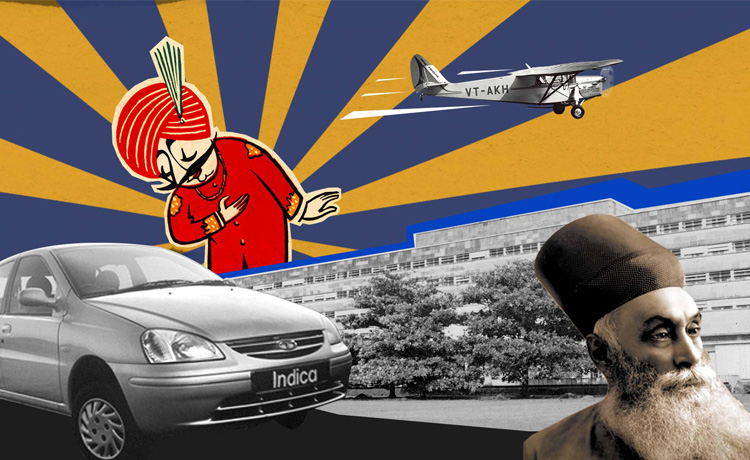
When you think of Indian corporate giants, a name that inevitably comes to mind is the Tata Group. As India’s largest conglomerate, its impact and reach are both vast and deep, with products and services touching millions of lives across 150 countries. Today, the collective value of its 29 publicly listed companies amounts to an astonishing $403 billion in market capitalisation.
From everyday essentials to high-end technology, the Tata Group has a stake in industries that fuel the economy and shape modern lifestyles. If you’re a tea lover, Tata’s Tetley brand has you covered. If you’re a coffee lover, Tata has brought you Starbucks, none less. Feeling hot? Tata’s Voltas air conditioners should bring you comfort. Want to check the time? Better do that on your Titan watch. Why not turn the TV on and watch your favourite shows on Tata Sky? Even 10-minute deliveries of groceries are within your reach, thanks to Tata’s BigBasket brand.
And let’s not forget the convenience of travelling in style with Tata Motors. Whether you’re driving a Tata car or taking to the skies on Air India, you’re riding on the wings of this corporate behemoth. The Tata portfolio doesn’t stop with household names—it expands to fashion, technology, and luxury. Westside and Zudio are among the top clothing brands in India right now, while Croma is the go-to place for buying electronics. And let’s not forget the Taj Hotels chain that offers an unparalleled experience in luxury hospitality.
Exploring the vast reach and global impact of India’s industrial titan Tata Group
The list of Tata brands is dizzying, and it seems there’s hardly an industry they haven’t touched. With such a staggering presence, it’s hard to imagine that this global empire had humble beginnings. Let’s take a journey back to where it all began.
How it all began

Imagine this! You’re living in the 1800s when the world is changing like never before due to the Industrial Revolution. European powers are waging wars, establishing colonies, and recruiting armies, all to loot our lands and fill their own coffers with more and more wealth. At the same time, India is facing mass famines, colonial exploitation, and, not to forget, political oppression. Amidst all this, in 1839, Jamshedji Tata was born. Little did his parents know that this little kid would defy all the plans of our colonial masters and establish India as an industrial powerhouse. That’s the reason why he’s called the “Father of Indian Industry.”
By 1858, he had graduated from Bombay’s Elphinstone College and joined his father’s trading firm that dealt in general merchandise. But general merchandise wasn’t something that interested Jamshedji at all. The American Civil War had caused a boom in the Bombay cotton market. Jamshedji Tata saw this as a huge opportunity. He purchased a bankrupt oil mill and turned it into a trading firm to begin importing and exporting goods such as cotton and textiles. This is the company that laid the foundation for what would later become the Tata Group.
Jamshedji’s Dreams

At that time, Jamshedji had four big dreams. He wanted to set up an iron and steel company, a unique hotel, a world-class learning institution, and a hydroelectric plant to supply electricity to millions of Indians. During his lifetime, only one could be realised. The iconic Taj Mahal Palace hotel was built in 1903 at the Colaba waterfront, making it the first hotel in British India to have electricity, American fans, German elevators, Turkish baths, and English butlers.
A landmark of luxury, the hotel attracted the who’s who of Indian and international society, including royals, dignitaries, celebrities, and businessmen. It was known for its opulence, lavish interiors, and impeccable service. In the mid-20th century, its aura dazzled further when guests like Lord Mountbatten, The Beatles, and Jacqueline Kennedy Onassis came and stayed there. Most recently, it was the likes of the Kardashian sisters who stayed there during the wedding of Anant and Radhika Ambani.
Despite establishing India’s premier hotel destination, three of Jamshedji’s dreams still remained unfulfilled. But that was the job of his successors.
Tata Steel – The Industrial Giant

In 1907, under the leadership of Jamshedji’s son Dorabji Tata, India’s first steel plant was born in Jamshedpur, a city named after Jamshedji himself. Tata Steel wasn’t just an industrial marvel but a symbol of India’s growing self-reliance.
From producing 1 lakh tons of steel in its early days, Tata Steel now produces 30 million tons annually and operates in 26 countries. In 2007, the Tata Group acquired Corus, a European steel giant, for $12 billion, making it one of the largest steel companies in the world.
Tata Power – Leading the Charge in Energy

Jamshedji Tata’s dream of generating electricity for the nation was brought to life by Dorabji Tata in 1911 when Tata Power was founded. Today, Tata Power is India’s largest integrated power company, with a generation capacity of over 13,000MW, including significant investments in renewable energy.
Tata Power is driving India’s shift towards sustainable energy, with ambitious goals to increase its renewable portfolio. In 2023, the company’s renewable energy arm was valued at over $7 billion, highlighting its commitment to a greener future.
Air India – Flying Ahead

In 1932, JRD Tata founded an airline known as Tata Air Services. In 1953, the Government of India passed the Air Corporations Act and purchased a majority stake in the carrier. That’s when the Air India we know today was born. After the airline’s privatisation in 2021, Tata re-acquired it, marking a new chapter in its legacy.
Additionally, Tata partnered with Singapore Airlines to launch Vistara in 2013 and with the AirAsia Group to launch AirAsia India in 2014. Right now, the Tata Group has a controlling stake in Air India, Vistara, and Air India Express and is the second-largest player in India’s aviation market. Together, these ventures showcase Tata Group’s commitment to enhancing India’s aviation sector and providing diverse travel options for millions of passengers.
Tata Motors – Driving India Forward

Tata’s journey into the automotive industry began in 1945 with Tata Motors, under the leadership of the great JRD Tata. Under the leadership of Ratan Tata, though, the Tata Motors story went truly global. In the year 2008, it acquired the iconic British brand Jaguar Land Rover for $2.3 billion, proving its place in the global automotive market. Today, Tata Motors earns $40 billion annually and continues to innovate, with electric vehicles and sustainable mobility leading the way.
2008 was also the year Ratan Tata uttered the famous words, “A promise is a promise,” while launching the Tata Nano, reassuring millions of Indians that despite the challenges, the Tata Nano will indeed be available to buy at one lakh rupees only. The Nano gave Indians a safer alternative to motorbikes and scooters and, despite its rather quick discontinuation, cemented its place in the annals of automotive history.
Tata Consultancy Services – The Tech Powerhouse

It was under JRD’s leadership that Tata’s foray into technology began in 1968 with the birth of Tata Consultancy Services (TCS). From a modest IT services firm, TCS has grown into one of the world’s largest IT companies, employing over 600,000 people across 46 countries.
Today, TCS has a market capitalization of more than $180 billion, and its services are integral to the operations of Fortune 500 companies across the globe, earning an annual revenue of $27 billion.
Tata Consumer Products – Nourishing India and Beyond

Tata’s reach extends to our daily lives through Tata Consumer Products. Whether it’s Tata Tea, which serves over 700 million cups daily, or Tata Salt, a staple in every Indian kitchen, the company has made a significant impact on consumer goods.
In collaboration with global brands, Tata has brought Starbucks to India and offers premium bottled water under the Himalayan brand. Tata Consumer Products earns over $1.3 billion annually and continues to expand its footprint.
Post-Liberalisation – The Ratan Tata Legacy

When Ratan Tata became chairman of Tata Sons in 1991, the group’s revenue stood at approximately $4 billion. By the time he retired in 2012, the revenue had soared to a remarkable $100 billion.
Ratan Tata’s strategic initiatives, such as acquiring global brands like Jaguar Land Rover and Corus Steel and expanding the group’s presence in sectors like technology, automobiles, and telecommunications, significantly boosted the company’s international footprint.
His focus on innovation and modernisation, combined with his commitment to ethical business practices, transformed Tata from an Indian conglomerate to a global powerhouse.
The Tradition of Philanthropy – Tata’s Commitment to Society
But the name Tata is not just about business. Over 66% of Tata Sons’ shares are held by philanthropic trusts, and the company has donated billions to healthcare, education, and social causes. We are indeed aware of Ratan Tata’s philanthropic endeavours, but did you know that he’s merely following a tradition that Jamshedji Tata established way back in the day?
Would you even believe that Jamshedji was named the Greatest Philanthropist of the 20th Century, as he had donated approximately $102.4 billion (inflation-adjusted) to education and healthcare during his time? Whether it’s building hospitals, funding research, or creating educational institutions like the Indian Institute of Science, the Tata Group has always believed in giving back to society.
The Tata Future
From its humble origins to becoming a $130 billion global conglomerate, Tata’s journey is a testament to vision, perseverance, and a deep-rooted commitment to making the world a better place. As Tata continues to innovate in areas like electric mobility, digital transformation, and sustainability, one thing remains clear: Tata is not just a company; it’s a legacy.

